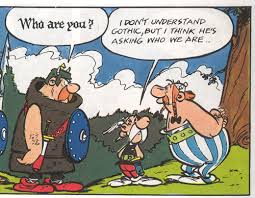What do modern Goths have to do with ancient and medieval ones?
Ostensibly, the answer to this question is ‘not much’, apart from a name. The Goths were a group of Germanic tribes who during late antiquity sometimes fought against the Romans and sometimes served in the Roman army. They killed the Emperor Valens at the Battle of Adrianople in 378, sacked Rome in 410, and later formed kingdoms in southern France, Spain and Italy that turned out to be quite ‘Roman’ in the way that they were run. Modern-day Goths wear black clothes, like depressing music and are generally a miserable bunch, at least if you believe South Park.
Some students and I did a bit of work on modern Goths in the last semester and here’s what we came up with by searching for videos on YouTube of people talking about what it meant to be a Goth in the modern world or that made some other kind of comment on Gothic identity:
The videos reveal how important it is to think about identity as a constructed by individuals and groups and that ideas of ‘who we are’ rely on a kind of interaction between both ‘insider’ and ‘outsider’ perspectives. The problem in antiquity is that we usually only have partial evidence and it’s often from a strongly ‘Roman’ or ‘Gothic’ perspective. For the modern Goths, that’s not such a problem – there’s lots of evidence out there, if you know where to look.
Modern-day Goths on YouTube self-define their identity culturally. According to them, Goths have a distinct sense of fashion and style. Musical tastes are often mentioned as important defining features of what is means to be a Goth today. This identity is grounded historically by reference to ‘the Gothic’ rather than to ‘the Goths’ of the past: for example, having read 19th century Gothic novels. Ancient Goths are only mentioned (infrequently) as fellow ‘outsiders’: they occupied a place outside the Roman imperial system just as Goths today often see themselves as standing apart from conventional society. Some Gothic YouTubers have a strong sense of what it means to be a ‘proper’ Goth and exclude from the category those who do not meet their criteria, while others are concerned to draw distinctions with other groups (Emos, Punks…) or to break down modern Goths into sub-groups.
YouTube also contains plenty of videos which provide us with ‘outsider’ views on the Goths, in the same way that we’re reliant on Roman source for early Gothic history in antiquity (and, some scholars would argue, for most of the rest of their history too). On YouTube this often takes the form of satire/ comedy, as in the case of South Park’s Goth Kids (see above) or Richmond from the IT Crowd.
Interestingly, the ‘outsider’ videos often pick up on the same characteristics as the ‘insider’ YouTube clips: music, fashion, attitude (though often satirised as unremittingly miserable). Culture defines identity for those poking fun at the Goths as well.
Viewing this topic through the YouTube videos provides a novel perspective on the issue of identity in ancient history which often seems so distant and abstract. Modern Goths may not have much at all to do with ancient ones, but they can help us think about some of the issues that confronted the Goths as outsiders within a largely Roman world.
For more on this and other teaching using digital methods at the University of Lincoln, see our Making Digital History website or follow us on Twitter @MakDigHist.


Fun post! I did once know a guy, now at the University of Sheffield, who owned a t-shirt that got at the social hierarchy within the goth movement by reading, “Where were you when we sacked Rome?”, and presumably they made and sold more. And I’ve been in one fabulous Internet argument on a music listserv about whether the Huns or Goths gave rise to better bands, although to be fair medievalists were involved in that one. So the longer-historical consciousness about the name is not completely missing! But the goth movement actually seems to have a fairly poor idea of its own history, something that the older members are now increasingly regretting. This is of course the problem with a group that people recognise by means of dress and behaviour: how to transmit the Traditionskern when anyone can start acting as a member? And equally, why in the sixth century do we not have more people arguing about whether someone is properly Goth, as we have in the 1990s? Is that what the Visigothic Law aims to end? Or is it just that the new movement is fuelled in part by modern media and that that can now go viral via the Internet in a way that means no authority can police the status? Lots can be done by playing with this coincidence of names?
Thanks for the comments, Jonathan, and for the link to the History of Goth website (http://www.historyofgoth.com/), I’ll be looking at this before teaching the topic again, for sure. This was definitely intended as a ‘fun’ activity to keep the students attending in the final week of term (and it worked to some extent), but several students actually ended up including some reference to it and the secondary sources they’d read in their essays.
I’m actually reminded of a blog post of your’s that I came across again a week or two ago (http://tenthmedieval.wordpress.com/2011/07/21/theodulf-goths-and-garrisons/) which I think makes similar kinds of points about names, naming and the claiming of names, and their relation to any ‘actual’ Goths (or not).
Thankyou! I did enjoy tjhat post. Meanwhile, not the shirt I remember but the gag goes on: buy it (or at least point at it) here!